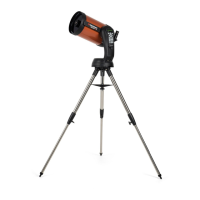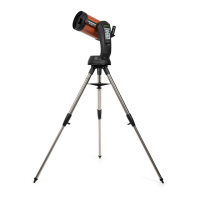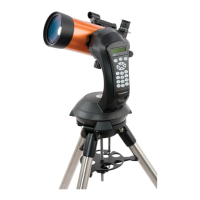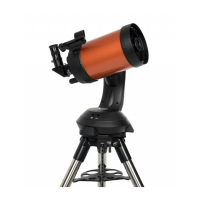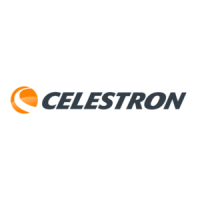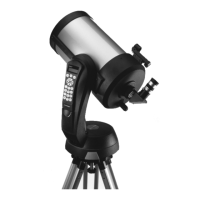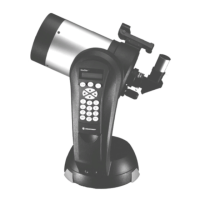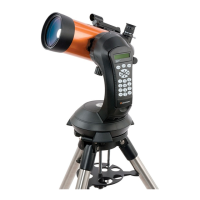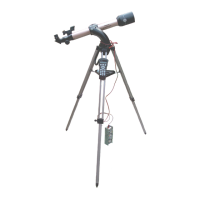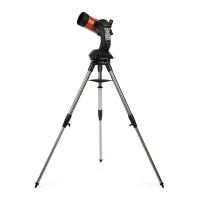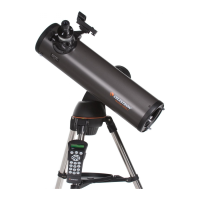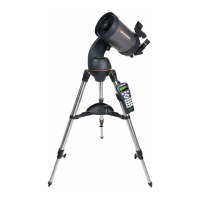Do you have a question about the Celestron NexStar 6 SE and is the answer not in the manual?
Essential safety guidelines for using the telescope, including solar viewing and supervision.
Step-by-step instructions for physically assembling the telescope components.
Guide on installing batteries and turning the telescope on.
Information on connecting and the basic function of the hand control unit.
Instructions for attaching the star diagonal and inserting an eyepiece.
Steps for mounting the star pointer finderscope to the telescope.
Guidance on operating the star pointer for alignment and object acquisition.
Procedure for safely detaching the telescope's optical tube from the mount.
Instructions for extending, leveling, and securing the telescope tripod.
Steps to securely attach the telescope base onto the tripod mounting plate.
Detailed explanation of the hand control's LCD screen and key buttons.
General procedures for operating the telescope using the hand control.
Explanation of why telescope alignment is crucial for accurate pointing.
Inputting essential site and time information for the Sky Align method.
Steps for centering alignment objects in the eyepiece during Sky Align.
Guide to performing the automatic two-star alignment process.
Procedure for manually identifying and centering two alignment stars.
Simplified alignment using a single known star.
Using solar system objects for telescope alignment.
Overview of polar alignment for equatorial mounts.
Method to update alignment stars for better pointing accuracy.
Procedures for specific equatorial alignment types.
Feature to improve pointing accuracy in a specific sky region.
How to browse and select celestial objects from the database.
Techniques for moving the telescope and locating planets.
Using automated features for guided celestial object tours.
How to use direction buttons and adjust slew rates.
Setting the telescope's tracking behavior and speed.
Managing site information and saving custom celestial objects.
Using the Identify mode to find and recognize celestial objects.
How to use Precise GoTo for enhanced object pointing accuracy.
Introduction to various scope setup configurations.
Setting telescope movement limits and object visibility filters.
Managing GPS, display settings, and resetting the telescope.
Managing power saving, sun display, and goto calibration.
Utilizing Wedge Align to aid in polar alignment.
Explanation of the telescope's optical system and its components.
How accessories like star diagonals affect image orientation.
Procedures for achieving sharp focus and calculating magnification.
How to calculate the apparent and true field of view.
Advice on improving image quality by considering viewing environment.
Explanation of celestial coordinates used for locating objects.
How Earth's rotation causes stars to appear to move in the sky.
Steps for performing basic polar alignment using an equatorial wedge.
Using the Wedge Align feature to assist with polar alignment.
Essential camera features needed for celestial photography.
Instructions for connecting a camera to the telescope.
Guide on how to find the North Celestial Pole using star constellations.
Tips and safety advice for observing different celestial bodies.
Guidance for viewing faint deep sky objects like nebulae and galaxies.
Factors affecting atmospheric clarity and image quality.
Procedures for safely cleaning the telescope's optical surfaces.
Introduction to optical alignment and its importance.
Step-by-step guide to adjusting collimation screws for sharp images.
Details on common accessories like adapters, Barlows, and various eyepieces.
Information on filters, power supplies, sky maps, and camera adapters.
Comprehensive technical specifications for the telescope's optics and electronics.
Definitions of astronomical terms starting with A through E.
Definitions of astronomical terms starting with F through R.
Definitions of astronomical terms starting with R through Z.
How to connect and control the telescope via computer using NexRemote.
Map illustrating time zones across North and Central America.
Map showing global time zones and their relation to UTC.
Star chart depicting constellations visible from January to February.
Star chart depicting constellations visible from March to April.
Star chart depicting constellations visible from May to June.
Star chart depicting constellations visible from July to August.
Star chart depicting constellations visible from September to October.
Star chart depicting constellations visible from November to December.
Details on warranty coverage, exclusions, and the product return process.
Contact information for customer support and FCC compliance details.
Essential safety guidelines for using the telescope, including solar viewing and supervision.
Step-by-step instructions for physically assembling the telescope components.
Guide on installing batteries and turning the telescope on.
Information on connecting and the basic function of the hand control unit.
Instructions for attaching the star diagonal and inserting an eyepiece.
Steps for mounting the star pointer finderscope to the telescope.
Guidance on operating the star pointer for alignment and object acquisition.
Procedure for safely detaching the telescope's optical tube from the mount.
Instructions for extending, leveling, and securing the telescope tripod.
Steps to securely attach the telescope base onto the tripod mounting plate.
Detailed explanation of the hand control's LCD screen and key buttons.
General procedures for operating the telescope using the hand control.
Explanation of why telescope alignment is crucial for accurate pointing.
Inputting essential site and time information for the Sky Align method.
Steps for centering alignment objects in the eyepiece during Sky Align.
Guide to performing the automatic two-star alignment process.
Procedure for manually identifying and centering two alignment stars.
Simplified alignment using a single known star.
Using solar system objects for telescope alignment.
Overview of polar alignment for equatorial mounts.
Method to update alignment stars for better pointing accuracy.
Procedures for specific equatorial alignment types.
Feature to improve pointing accuracy in a specific sky region.
How to browse and select celestial objects from the database.
Techniques for moving the telescope and locating planets.
Using automated features for guided celestial object tours.
How to use direction buttons and adjust slew rates.
Setting the telescope's tracking behavior and speed.
Managing site information and saving custom celestial objects.
Using the Identify mode to find and recognize celestial objects.
How to use Precise GoTo for enhanced object pointing accuracy.
Introduction to various scope setup configurations.
Setting telescope movement limits and object visibility filters.
Managing GPS, display settings, and resetting the telescope.
Managing power saving, sun display, and goto calibration.
Utilizing Wedge Align to aid in polar alignment.
Explanation of the telescope's optical system and its components.
How accessories like star diagonals affect image orientation.
Procedures for achieving sharp focus and calculating magnification.
How to calculate the apparent and true field of view.
Advice on improving image quality by considering viewing environment.
Explanation of celestial coordinates used for locating objects.
How Earth's rotation causes stars to appear to move in the sky.
Steps for performing basic polar alignment using an equatorial wedge.
Using the Wedge Align feature to assist with polar alignment.
Essential camera features needed for celestial photography.
Instructions for connecting a camera to the telescope.
Guide on how to find the North Celestial Pole using star constellations.
Tips and safety advice for observing different celestial bodies.
Guidance for viewing faint deep sky objects like nebulae and galaxies.
Factors affecting atmospheric clarity and image quality.
Procedures for safely cleaning the telescope's optical surfaces.
Introduction to optical alignment and its importance.
Step-by-step guide to adjusting collimation screws for sharp images.
Details on common accessories like adapters, Barlows, and various eyepieces.
Information on filters, power supplies, sky maps, and camera adapters.
Comprehensive technical specifications for the telescope's optics and electronics.
Definitions of astronomical terms starting with A through E.
Definitions of astronomical terms starting with F through R.
Definitions of astronomical terms starting with R through Z.
How to connect and control the telescope via computer using NexRemote.
Map illustrating time zones across North and Central America.
Map showing global time zones and their relation to UTC.
Star chart depicting constellations visible from January to February.
Star chart depicting constellations visible from March to April.
Star chart depicting constellations visible from May to June.
Star chart depicting constellations visible from July to August.
Star chart depicting constellations visible from September to October.
Star chart depicting constellations visible from November to December.
Details on warranty coverage, exclusions, and the product return process.
Contact information for customer support and FCC compliance details.
| Aperture | 150 mm (5.91 in) |
|---|---|
| Focal Ratio | f/10 |
| Optical Design | Schmidt-Cassegrain |
| Mount Type | Single Fork Arm Altazimuth |
| Weight | 21 lbs (9.53 kg) |
| Magnification | 60x |
| GoTo | Yes |
| Database | 40, 000+ objects |
| Highest Useful Magnification | 354x |
| Lowest Useful Magnification | 21x |
| Limiting Stellar Magnitude | 13.4 |
| Resolution (Rayleigh) | 0.93 arc seconds |
| Resolution (Dawes) | 0.77 arc seconds |
| Tracking Rates | Sidereal, Solar and Lunar |
| Focal Length | 1500 mm |
| Finderscope | StarPointer |
| Eyepiece | 25 mm |
| Tripod | Steel |
| Light Gathering Power | 459x |
| Star Diagonal | 1.25" |
| Power Supply | 8-AA batteries (not included) |
| Alignment Procedures | SkyAlign, Auto Two-Star Align, Two-Star Align, Solar System Align |
| Computerized Hand Control | NexStar+ |
| GPS Compatible | Yes (with optional SkySync GPS Accessory) |
